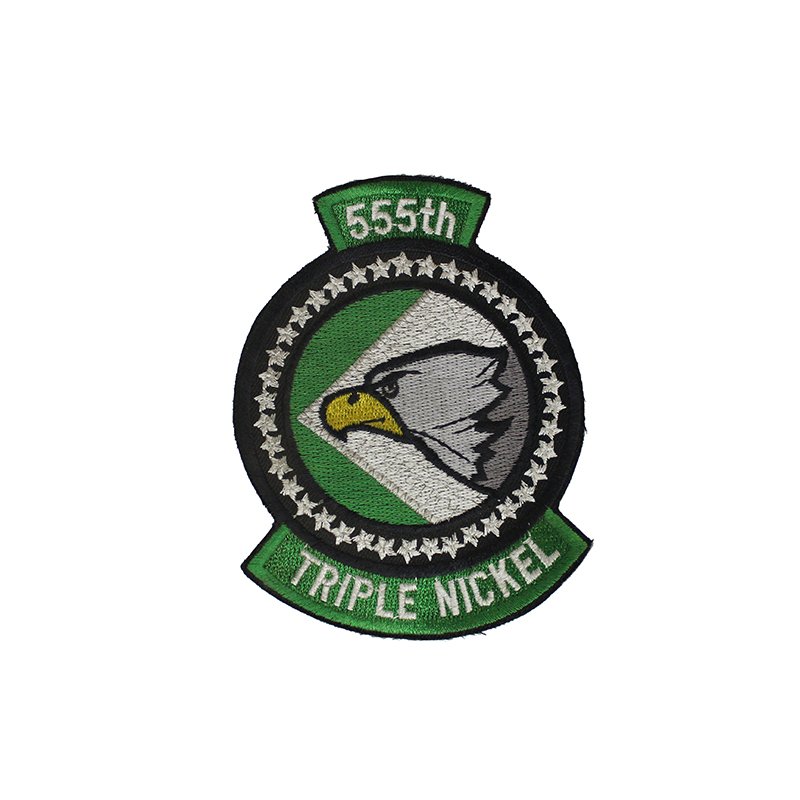The 555th Parachute Infantry Battalion was an all-black airborne unit of the United States Army during World War II.
- Sew on embroided patch
- 115x87mm
The unit was activated as a result of a recommendation made in December 1942 by the Advisory Committee on Negro Troop Policies, chaired by the Assistant Secretary of War, John J. McCloy. In approving the committee's recommendation for a black parachute battalion, Chief of Staff General George C. Marshall decided to start with a company, and on 25 February 1943 the 555th Parachute Infantry Company was constituted.
On 19 December 1943, Headquarters, Army Ground Forces, authorized the activation of the company as an all-black unit with black officers as well as black enlisted men. All unit members were to be volunteers, with an enlisted cadre to be selected from personnel of the 92d Infantry Division at Fort Huachuca, Arizona.
The company was officially activated on 30 December 1943 at Fort Benning, Georgia. After several months of training, the unit moved to Camp Mackall, North Carolina, where it was reorganized and redesignated on 25 November 1944 as Company A of the newly activated 555th Parachute Infantry Battalion.
World War II
The battalion did not serve overseas during World War II, primarily because it never reached full strength for an Airborne Infantry Battalion. In reaction to the German counterattack that began the Battle of Bulge, the Airborne Command considered reorganizing the 555th PIB as a single reinforced Airborne Rifle Company, and sending it to Europe to reinforce the battered Airborne units already there. However, before this could happen the crisis had passed, and the 555th PIB was instead alerted for deployment to the West Coast. The men of the 555th PIB hoped that they would get into the war against the Japanese, but that was not their new mission. According to Sergeant Walter Morris, "It was a secret mission called Operation Firefly. We thought we were going overseas to [Gen. Douglas] MacArthur's theater." It wasn't until they arrived in Oregon, in May 1945, that they learned they would be fighting the Japanese on the fire line in the Western United States.
During the winter of 1944–45, the Japanese sent 9000 Fu-Go balloon bombs toward the West Coast of North America. It was believed 1000 succeeded in reaching the United States; 312 balloon bombs have been found. After three days, each balloon dropped an incendiary bomb. The balloon bombs employed a ballast system designed to maintain an average altitude of 30,000 feet. Incendiary bombs would be dropped one at a time (four 11 pounders) and a single high-explosive bomb (33 pounds) would be dropped followed by a self-destruct device. In order to conceal the efficacy of these attacks, the missions of the 555th PIB was kept clandestine in nature. By January 1945, however, both Time and Newsweek reported the mission. Despite the fear of the incendiary bombs, none of the 1945 season were attributed to the balloon incendiaries, nor were any fires started by the balloon bomb program at all. Stationed at Pendleton Field, Oregon (formerly the base of the pilots and aircraft selected for the Doolittle raid on Japan), with a detachment in Chico, California, unit members participated in fire-fighting missions throughout the Pacific Northwest during the summer and fall of 1945. The 555th worked on twenty-eight fires during the 1945 season. Of these, fifteen fires were "jumped" or parachuted to. While some United States Forest Service reports refer to some employees as smokejumpers, the 555th were reported as paratroopers on all fire reports. The only fatality in the unit died while jumping on 6 August 1945.
The 555th Parachute Infantry Battalion was nicknamed the "Triple Nickles" because of its numerical designation and the selection of 17 of the original 20-member "colored test platoon" from the 92nd Infantry (Buffalo) Division. Hence, the origin of the term Buffalo Nickles; the spelling derives from old English. Three buffalo nickels joined in a triangle or pyramid is the identifying symbol.
Soon after returning to Camp Mackall in October 1945, the 555th Parachute Infantry Battalion was transferred to Fort Bragg, North Carolina, its home for the next two years. During this period the unit was attached to the elite 82d Airborne Division. When the battalion was inactivated on 15 December 1947, its men were all transferred into the 3d Battalion, 505th Parachute Infantry Regiment of the 82nd Airborne Division, which had been reduced to cadre strength to prepare for their arrival. Soon afterward, individual black paratroopers were transferred to units throughout the 82nd Airborne Division, making it the first integrated division in the US Army.
Inactivated
After its inactivation, many former 555th PIB members later fought in the Korean War in other units. First Lieutenant Harry Sutton, one of the battalion's former officers, died leading a rearguard action during the Hungnam evacuation and was decorated posthumously with the Silver Star. In 1950, a large number of former 555th PIB members volunteered to form the all-black 2nd Ranger Infantry Company (United States). While the 2nd Ranger Company was attached to the 187th Infantry Regiment (United States), it made the combat jump at Munsan-Ni in March 1951, the first combat jump ever made by a US Army Ranger unit.
Clarence H. Beavers, the first volunteer for the 555th, went on to a career in computer systems with the Veterans Administration and US Defense Department, and served as a volunteer firefighter in retirement. He was the last surviving member of the unit when he died in 2017, at age 96.
